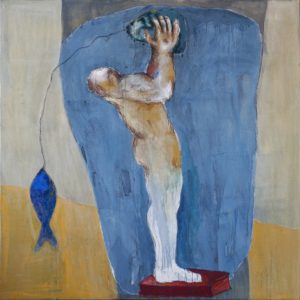
Sadikou Oukpedjo
Reflet 2, 2018
About:
Acquired his professional training in the studio of Togolese artist Paul Ahi, where he specialized in sculpting and drawing. There, he delved into the recesses of local artistic heritage in order to apply it in his own work. Today, Oukpedjo claims, his art is completely detached from Togolese or West-African traditions. He therefore entitles himself to create a universal epic on the belligerent confrontation between Nature and Humanity. Like other mythmakers before him, Oukpedjo gives meaning to existential conditions. Unlike them, his epic tale is plotless and has no protagonist or victors. The only recurring motif in Oukpedjo’s works is the struggle between humans and animals. Paradoxically, the forced detachment from his original culture does not leave him disconnected or in a constant search for roots. Instead, it allows him to simultaneously connect to a time-honored European romantic tradition, as well as to African mythologies that address similar confrontation.

Source, 2018

Armure 1, 2018

Pelerinage, 2018
The depicted struggles in Oukpedjp’s paintings produces hybrids – a fish with a human foot for a tail, an animal-headed man, or other dissected mutations. The hybrid characters create a dramatic effect that inheres passion and violence, yet unlike other mythologies, Oukpedjo does not wish to offer a moral to the story. The artist refuses to give explanations of his work and leaves the viewer in a realm of endless inquiry and questioning.
Oukpedjo’s varied coloring techniques and changing finishing levels reinforce the deceptive shifting between completeness and incompleteness, leaving room for a flexibility of the imagination. The sense of suspended completeness betrays disorder yet hold the possibility for change. The dissection of the heroic, mythic body of both African and European cultures embodies the ability to start anew, to structure a more equal footing in reality. In many cultures, pairs of opposites are seen as a unifying vital force. In many artworks, the harmony is produced by opposites, or alternatively, dichotomies disrupt the order of the familiar image, inviting the viewer to reexamine and thereby interpret the uninterpretable.
